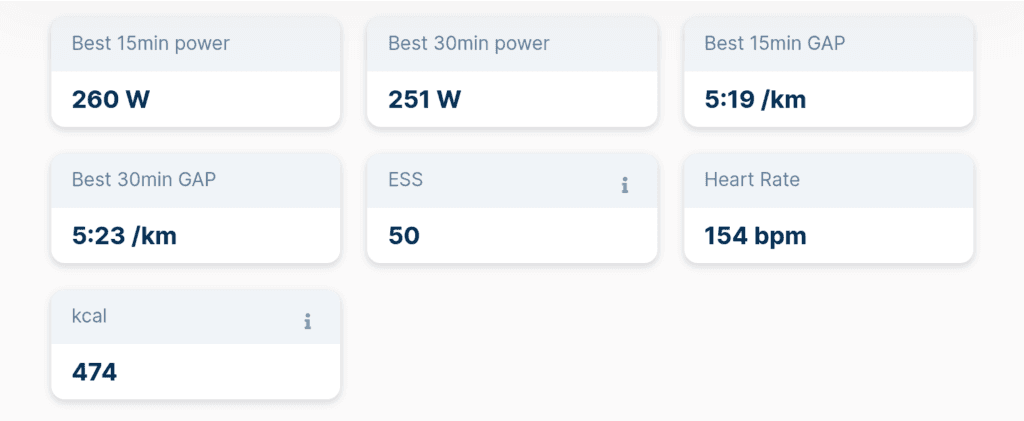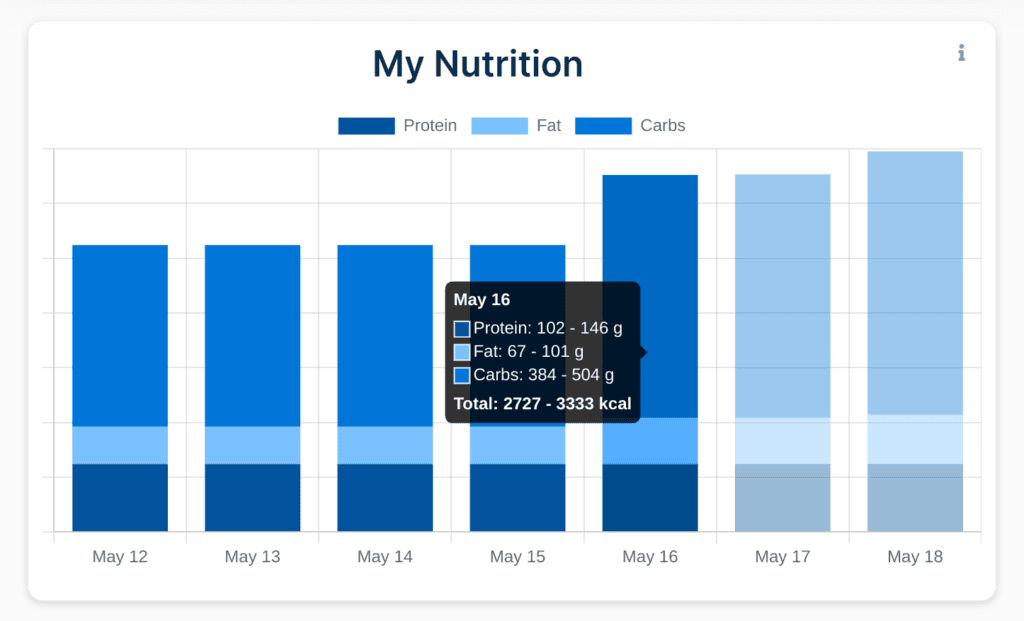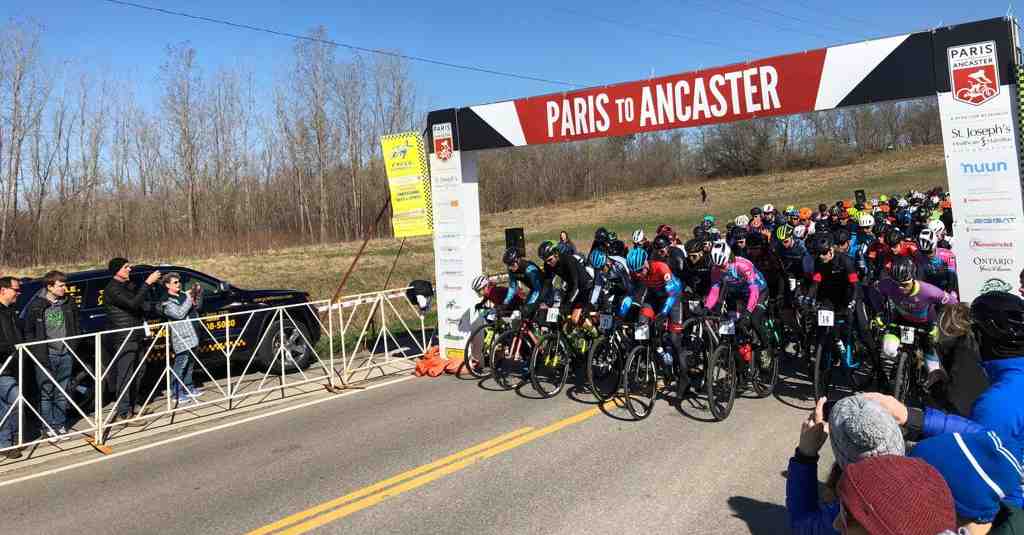
When it comes to excelling in endurance sports such as triathlon, running or cycling proper nutrition plays a crucial role in maximizing your performance and achieving your goals. Whether you're swimming, cycling, or running, your body requires optimal fuel to meet the energy demands of these activities. In this blog post, we'll explore the importance of nutrition in triathlon, running, and cycling, followed by an introduction to the new feature of AI Endurance which provides recommendations for daily and activity specific nutrition requirements individualized for each athlete.
With the help of exercise physiologist and nutrition expert Ida Heikura, AI Endurance has developed an evidence based tracking and prediction algorithm to estimate your daily (total) and exercise-specific requirements.Furthermore, we offer a range of recommended intakes of proteins, carbohydrates and fats depending on your exercise routine.
Understanding the energy requirements during exercise is a complex task, prone to errors and variations based on multiple factors [1]. However, to provide you with a general idea of the energy cost associated with each exercise session, AI Endurance utilizes evidence-based equations specific to the type of exercise [2-5]. It's important to remember that individual variations, such as age, sex, health and fitness status, body composition, and genetics, can influence the true energy cost of exercise.
You can now find a predicted energy cost (in kcals) for every planned future exercise in your AI Endurance training plan, as well as for any completed swim, bike or run activity.

The total daily energy requirement of an individual is a sum of the following components:
However, accurately estimating all these components can be challenging, leading to potential errors. Therefore, daily energy requirements are provided as a range, allowing flexibility and adjustment based on your needs.
For individuals engaging in energetically demanding activities outside of exercise, such as firefights or non-tracked bike commutes, it's crucial to understand that their true energy requirements are likely to exceed the predictions based on average individuals. Overall, daily energy recommendations have been developed with the aim of maintaining energy balance or optimal energy availability, optimized triathlon nutrition, fueling and recovery from training. It is important to note that these calculations are not intended for weight-loss or calorie restriction purposes.
AI Endurance gives you a daily range of kilocalories as well as macronutrients in your dashboard. These take into account both past and future activities and provide you with a range of calories required to appropriately fuel you for your activities. A good starting point might be to aim somewhere in the mid-range for individual macronutrients and total daily calories; and subsequently scale up or down based on experience.

In addition to daily energy targets, macronutrient recommendations are equally important for proper triathlon nutrition. These recommendations focus on the optimal and evidence-based distribution of protein, carbohydrates, and fats [7-11]. The daily targets for macronutrients and calories are presented as a range, offering flexibility within your meal plan.
Carbohydrates are the primary source of fuel for (higher intensity) endurance activities like triathlon. They provide the necessary energy to sustain your performance during long workouts and competitions while also providing a whole host of health benefits. Proteins are essential for muscle repair and recovery, promoting optimal training adaptations. Fats, while often underestimated, play a role in providing sustained energy and supporting overall health.
It's important to remember that nutrition should be personalized based on individual assessments, goals, and preferences. Consulting a registered dietitian or nutritionist can help you create a tailored diet plan that addresses your specific needs and maximizes your performance potential.
Achieving peak performance in triathlon requires meticulous attention to nutrition. By fueling your body with the right nutrients, you can enhance your energy levels, endurance, and recovery, ultimately leading to improved performance. Here are some key nutrition tips to help you excel in each discipline:
Running Nutrition: Prioritize carbohydrates in your pre-run meals and snacks to ensure sufficient glycogen stores, which are essential for endurance. Incorporate lean sources of protein to support muscle repair and recovery. Hydrate adequately before, during, and after your runs to maintain optimal performance.
Cycling Nutrition: Consume a balanced meal rich in carbohydrates and moderate in protein a few hours before your ride to provide sustained energy. During longer rides, replenish your energy with easily digestible carbohydrates such as energy gels or sports drinks. Don't forget to hydrate consistently to prevent dehydration and maintain performance.
Swimming Nutrition: Focus on pre- and post-swim nutrition to support your performance in the water. Consume easily digestible carbohydrates before your swim to fuel your muscles. After swimming, prioritize protein-rich foods to aid in muscle recovery and repair.
In conclusion, triathlon nutrition is a key factor in unlocking your full potential as an athlete. By understanding your daily energy requirements, macronutrient distribution, and the specific nutritional needs for each discipline, you can optimize your performance and achieve your goals. Remember, personalized nutrition guidance from a registered dietitian or nutritionist is invaluable in developing a diet plan that caters to your individual needs and aspirations. Fuel your body right and watch your triathlon performance soar to new heights!
Measuring and estimating the energy cost of various forms of human locomotion is inherently challenging and prone to errors. Therefore, the estimated values for energetic requirements for any specific activity as well as for daily maintenance of energy balance provided by AI Endurance are only an approximate estimate of true energy requirements. In addition, macronutrient targets have been given based on the most recent recommendations on nutrition for endurance athletes and activities; while these targets are likely to suit most individuals, you should always consult a sports nutritionist or dietitian for individualized advice.
The guidelines and information contained within this app on energetic and nutritional requirements are not intended to be a substitute for individualized professional or medical advice from a medical provider, registered dietitian, or other registered healthcare provider. Although the information provided is evidence-based, it should be treated as purely educational and informative. The information provided within this app is not intended to be nutritional or medical advice nor is it individualized to the user and their specific circumstances (genetics, anthropometrics, lifestyle considerations, etc.). We will not be held responsible for any errors or omissions, and we accept no liability whatsoever for any loss or damage you may incur. Always seek medical or professional advice for your specific circumstances as needed for any questions and concerns you now have or may have in the future.

Paris to Ancaster is the biggest gravel grinder bike race in Canada. It’s in 8 weeks and I need to get in shape. AI Endurance can predict race performance and create a training plan which is optimized to my training responses. It predicts that I can increase my FTP by 14% to 293 Watts on race day with just 3.5 hours of training a week.

by Grant Paling. Our increasingly digital society is becoming more and more data driven. And with that, we make decisions. I hear a lot the phrase “if you torture the data long enough it will tell you whatever you want.” I get it but I also think that’s usually the phrase used by someone who doesn’t WANT to believe the data. Because good data is hard to argue with.

Power meters are costly and we often can't afford one on every bike we own. AI Endurance calculates cycling power from activities without a power meter using heart rate, cadence and DFA alpha 1. The results are generally more accurate than speed based estimates such as Strava's estimated power. All you need is a heart rate monitor and ideally a cadence sensor on your bike and AI Endurance will estimate your power for every ride.

The world around us is changing, driven by technological advances that seek to improve our lives.